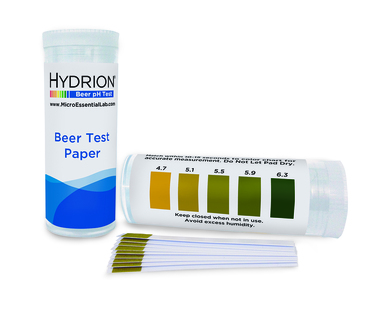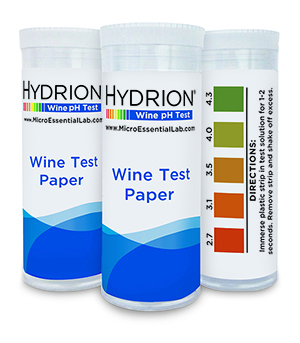Quality Beer and Wine pH Test Strips
Posted by EG on Dec 15th 2022
Beer pH Testing Strips

What test strips should be used to measure mash and wort pH?
Supervising the pH of the Mash, Wort, and Beer is necessary as the Yeast will develop differing physiological states, and the presence or absence of organic acids and the use of mineral Ions during the fermentation process will cause changes in acidity or alkalinity. This in turn affects enzyme activity in the yeast.
Before, and during the process of fermentation, a measure of the pH of the solution is very important. The correct pH must be established first, and should be monitored throughout the process in order to aid the complete breakdown of the initial carbohydrates to alcohol. This measure of pH may be accomplished with the pH 2-10 test paper. In addition, the pH 1-14 test strips can be used to test the acidity (pH) of the juice/must/beer prior to and during the process of fermentation. For an initial measure of the pH of the mash for beer, a narrow range measure can be obtained using the pH 4.7-6.3 test strips.
The pH of yeast is best at 5.2-5.5. Malted barley will release phosphate ions, and these will cause the water to be buffered at a pH of 5.6. Attaining an optimum pH range will ensure more complete conversion of starches in grain to fermentable sugars and proper hop utilization will occur.
Wine pH Testing Strips

Beginners in the wine-making field have a lot to learn when it comes to creating the perfect batch of wine. Your path will start with trial and error, learning the brewing process, ingredients and flavors, bottling, spoilage, etc. There are many different aspects to making wine, but we are here to discuss measuring the pH.
pH is a fundamental part of the wine-making process and the end product. The right pH level will result in a balanced taste and a stable wine. If the pH is too low (acidic), the wine is more likely to spoil or oxidize.
If you are not using a wine kit or trusted recipe, or if you are using fresh fruit or fruit that tastes especially sharp or sour, you need to check the pH. Any time you make wine from fresh wine grapes or you’re using a wine must made of 100% fruit juice, such as apple wine, you should always check the pH.
So, when should you test the pH?
The first thing you should do is check the pH before you start fermentation. Make sure you do this before you add the yeast so you can make changes to the must if needed. If fermentation has already started, the CO2 gas will result in an incorrect reading. Pour a sample of the solution into a cup, dip our pH 2.7-4.3 wine test strip into the sample for 1-2 seconds, and match within 10-15 seconds to the color chart specific to pre-fermentation. Remember, these strips don’t work the best with red wines, as the red will stain the strip, making it difficult to read the color results.
You should also check the pH before you bottle your wine, but make sure the wine has been degassed first. Remember, any CO2 gas leftover from fermentation will result in a false reading.
Ideally, you want a pH reading between 3.4 and 3.8. This is going to give you a balanced flavor that is not too alkaline or too acidic and susceptible to spoilage and oxidation.
Remember, total acidity and pH are two different factors in wine. You will need to perform separate tests to determine the total acidity.
No matter what you need when it comes to testing Level 7 Chemical has you covered with quality products! Check out more of our pH papers and our variety of kits here!
